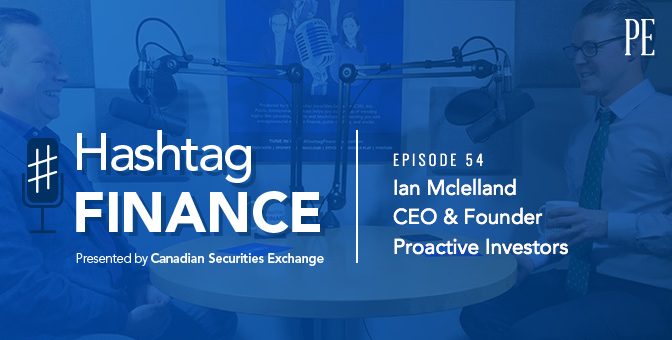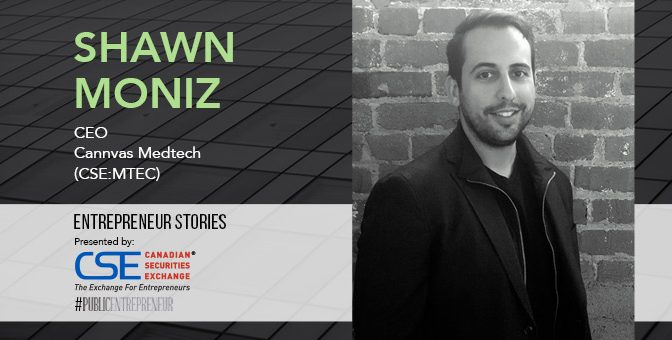Ian Mclelland, CEO and Founder of Proactive Investors, joins James Black to discuss how he turned his investing blog into a global financial news business (2:01), what Proactive offers that goes beyond the range of traditional news media and how they maintain their broadcast standards (8:24), why it’s important to have a global footprint in the industry (14:06), and how they create mutually beneficial relationships with third party syndication sites (20:22). Listen until the end to learn how investor interests and preferred media format vary by region, why Proactive created their app, and for Ian’s advice to publicly-listed companies on maintaining visibility and building trust with shareholders.
Tag Archives: Proactive Investors
Cannvas MedTech: Knowledge is king in the cannabis world too, says chief of Cannvas MedTech
“We really want to be the Google of cannabis data,” is how Chief Executive Officer Shawn Moniz sums up the mission of Cannvas MedTech (CSE:MTEC), a Toronto-based startup that specializes in educating the public about marijuana.
Having watched from the sidelines as Canadian companies sprung up to offer marijuana and its associated hardware, such as vaporizers, Moniz chose the less-travelled road of education when he launched his own cannabis company.
“The benefit of being a digital reference library of cannabis is that we can go into any country and people can learn about the different uses and a safe way of using cannabis if they so choose,” he says. “We are not dependent on any type of legislation or political maneuvering because it’s education, and education has no borders.”
Cannvas MedTech went public in July on the Canadian Securities Exchange as well as the Frankfurt Stock Exchange.
“We wanted to carve a little niche for us,” Moniz says. “We found there were a whole bunch of people growing … and on the other side, everyone was getting into devices, vaporizers and oil vaporizers. But we thought we don’t really want to go into those two spaces.”
Moniz decided instead to offer straight talk about cannabis after spending five years building platforms for big pharmaceutical companies like Pfizer, AstraZeneca and Bayer – which tended to put patients first in discussions about drugs.
He was concerned that the information being disseminated about cannabis reflected the interests of the licensed producers funding it. “We saw very biased information,” he says. “There was a need that no one was willing to plug.”
“So, I said hey, why don’t we just do what I did in the digital pharma space and bring that patient-centric approach to the cannabis industry,” he adds.
At the core of Cannvas MedTech’s business is its website Cannvas.Me, which provides online cannabis courses for free. Cannvas.Me offers the chance to read about cannabis’ medical applications in materials put out by physicians along with an online cannabis course, marijuana product reviews and a cannabis strain matcher that determines which variety is suitable for a specific ailment. The goal is to reach 100,000 users of the platform by the year’s close.
As more marijuana buyers explore Cannvas MedTech’s web site, they will provide data that will power the analytical side of Cannvas’s business, which has the lofty goal of providing the equivalent of census data for the cannabis industry.
Indeed, layered just below its education platform is Cannvas Data, which uses algorithms to pull apart the research on cannabis trends and find new data that might be of use. Via its connections to other cannabis companies, academics, doctors, and governments as well as its own web site, Cannvas management is set to ramp up its data collection around the world.
As Cannvas MedTech’s business takes off, the idea is that its data will become more tailored to the marketing needs of cannabis companies and the research needs of governments, physicians and academics. Its management will be able to tell, for example, how the consumer tastes of a 25-year-old construction worker in Ontario compare to his or her counterpart in Australia. They might also be able to determine the extent to which patients at military bases are taking cannabis to address their cases of post-traumatic stress disorder.
“People educating themselves about cannabis is where we win. There’s a lack of awareness and a lack of education and the data is key to that,” notes Moniz.
Partnerships are pivotal to the company’s ability to gather information. In one of its most prominent tie-ups to date, the company recently signed a revenue sharing agreement for Cannvas.me with the Vancouver-based e-commerce platform Namaste Technologies, which runs medical cannabis patient portal Namaste MD that has a reach extending to 20 countries and boasts a database of 1.5 million users.
Namaste has developed the country’s first cannabis telemedicine app, available on iPhone and Android devices, which allows patients to connect to doctors or nurse practitioners for consultations within minutes.
“The data is really going to set us apart within the industry. The Cannvas.me platform on a global basis will collect all of that data and feed it back into the industry,” reports Moniz.
Cannvas Connect, meanwhile, is the third branch of the business as it offers a secured network to allow for the sharing of Cannvas’s data with, say, Health Canada or the company’s other partners in academic and medical circles.
“Cannvas Data and Cannvas Connect, that’s where we have partnerships with academics and research facilities and we’re trying to do partnerships with the government in Canada,” points out Moniz. “We have analysts here providing insights and trends within the community and global markets.”
While 80% of the business is focused on Canada, the remainder is global and Moniz reports that Cannvas is already reaching out to clinics in Australia and Germany to introduce its software so Australians and Germans can have information on medical cannabis at the doctor’s office. Its management also recently travelled to Hong Kong and Japan and hosted presentations there. “In most parts of Asia, you can’t buy cannabis or legally obtain it,” says Moniz. “But playing on that education format opens up a lot of doors for us.”
The company’s goal is to have software in at least 100 clinics within the next year.
Keen to remain independent from the clutch of licensed marijuana producers who control the industry, Moniz and his management team opted to take Cannvas public instead of approaching companies for money. “We wanted to remain non-biased so the only way to do that is to make sure we got funding agnostic of any licensed producer,” he says.
Since its launch last September, Cannvas has built up a staff of 19 with offices in Vancouver and Toronto. As Cannvas widens its global reach by introducing its software in clinics around the world, it aims to become the international authority on the cannabis sector. Information will drive the company forward, along with the industry itself, Moniz believes.
“From a marketing perspective, it’s very important for the cannabis sector to know who their market is,” says Moniz. “Right now, everyone is just blasting out the same message to everyone whether you’re a medicinal or a recreational user. It’s one message fits all.”
This story was originally published at www.proactiveinvestors.com on August 31, 2018 and featured in The Public Entrepreneur magazine.
Learn more about Cannvas MedTech at https://www.cannvasmedtech.com/ and on the CSE website at https://thecse.com/en/listings/life-sciences/cannvas-medtech-inc.
Going Public? Put a Communications Upgrade Near the Top of Your To-do List
Congratulations on taking your company public on the Canadian Securities Exchange. You have made a wise decision that will benefit you, your team and your company in many ways.
With your new status, however, comes responsibility to an expanded base of shareholders and a duty to maximize the value of your company in a manner different than when you were private. Now, the value of your organization is reassessed by the investment community every second of the business day.
Build it and they will come? Don’t believe it for a moment. There are thousands of listed companies in North America vying for the attention of the investors you seek, and the companies that attract them are the ones who combine business success with marketing savvy to ensure they are at the front of the line when investors scout around for ideas.
Unless you know every shareholder in your company and have a good portion of the financial community in your digital rolodex, you will need assistance with communications.
How much assistance? A typical IR budget for a microcap stock is in the range of $100,000 per year. This includes travel to meet investors and investment professionals, participation in a handful of carefully chosen events, digital outreach to keep the story live 24 hours a day, and perhaps an external IR firm to bring an instant base of interested parties. If you are sufficiently mature as a corporation, an internal IR manager might be a consideration. And…we’re already closing in on $200,000.
A lot of money, right? Well, if a $200,000 outlay adds to your market capitalization by $3 million (6 cents per share assuming 50 million shares outstanding), few will argue the money was not well spent. Especially if you plan to raise equity capital anytime soon.
Add in satisfied investors and better sleep at night, and it really is a prudent decision.
You’ll need people you can trust to guide you in putting your strategy together. There are plenty of hands who will take your money – ask around to make sure you team up with the ones who follow through with the promised effort. And while a company needs to be connecting with existing and prospective shareholders regularly, only spend money on a full suite of resources when you have the corporate developments to really leverage them.
A prevented sell has the same value as a buy. Inform your existing shareholders with regular written updates, media interviews, and an increasingly popular tool — video. Complement important press releases with a brief video explaining your latest results, how your process works, or what your new facility looks like inside. Let shareholders look the CEO in the eye online and take his or her measure.
A favorite related story involves a company whose stock was stuck between $0.50 and $0.80. Management put tremendous effort into investor relations, but no matter how hard they tried they could not break through $0.80.
One day, on meeting number 200+, the company met an analyst who got the story right away and encouraged their trading desk to begin buying the stock in size.
It was not long before the stock broke through $0.80…on its way to more than $3.00.
The point is that if you have a good company, there are investors out there who will see what you see, adopt your vision and back you with money. But connecting with them is a numbers game. Reach out to a few dozen people and you will have to be very lucky to find backers. Reach out to a thousand and your odds can start to look pretty good.
This story was written by Peter Murray and featured in Service Providers magazine.
CSE TV Issuer Profile: Newnote Financial Corp.
Recently profiled at Proactive Investors (click here to see the full article), we are excited to showcase Newnote Financial Corp. (CSE:NEU) – our latest company profiled on CSE TV.
http://youtu.be/qMX8JqIt6q0
CSE CEO speaks with Proactive Investors
Richard Carleton, CEO of CSE – Canadian Securities Exchange recently spoke with Proactive Investors and discussed the recent rebranding from CNSX to CSE, the advantages of listing on the exchange, and touched on the specific reasons why Ned Goodman and Tom Caldwell are active investors in the company.
http://youtu.be/twRSIpp1e8s
CSE Chairman puts “our mouth where our money is” with Urbana listing on CSE
 Proactive Investors recently profiled one of CSE’s newest listings – Urbana Corporation – a closed-end investment company (CSE:URB and CSE:URB.A). The company’s Chairman, Thomas Caldwell is also the Chairman of CSE – Canadian Securities Exchange. In the article much is discussed around the reasons for co-listing URB shares on CSE. Other highlights from the article include:
Proactive Investors recently profiled one of CSE’s newest listings – Urbana Corporation – a closed-end investment company (CSE:URB and CSE:URB.A). The company’s Chairman, Thomas Caldwell is also the Chairman of CSE – Canadian Securities Exchange. In the article much is discussed around the reasons for co-listing URB shares on CSE. Other highlights from the article include:
- Tom’s concerns about over-regulation in the Canadian capital markets and how it’s curbing innovation (you can read Tom’s op-ed about over regulation here);
- A clear explanation of how the CSE listing model works and how it focuses on regular monthly disclosure from issuers in favour of exchange merit reviews from the exchange;
- Prospects for the closed-end investment fund model that Urbana utilizes – predicting this will be a more popular vehicle as mutual funds lose their appeal;
- Some insight into Urbana’s investment philosophy and the unique things the fund can do due to it’s size.
“Simplified CSE offers faster and cheaper approach to listing in Canada”
Proactive Investors (http://www.proactiveinvestors.com/) was kind enough to interview CSE CEO Richard Carleton regarding the company’s transition from CNSX to CSE – Canadian Securities Exchange.
The article covers a wide array of topics including why the name was changed, the difference that this will make for customers, and some of the initiatives that are planned for the upcoming year and beyond.
Some quick points from the article:
- CSE estimates that it accounted for 17% of the new issuers entering the Canadian public markets last year;
- CSE has combined Pure and CNSX into a single technical platform in an effort to simplify the brand and introduce efficiencies for customers;
- The exchange was recently backed by Dundee Corp. Chief Executive Ned Goodman and Tom Caldwell, Chairman of Caldwell Securities.
This is a great overview of where the CSE is at with respect to its leadership, product, and prospects moving forward – for the full article by Deborah Bacal please click the following link: http://www.proactiveinvestors.com/companies/news/51203/simplified-cse-offers-faster-and-cheaper-approach-to-listing-in-canada-51203.html



